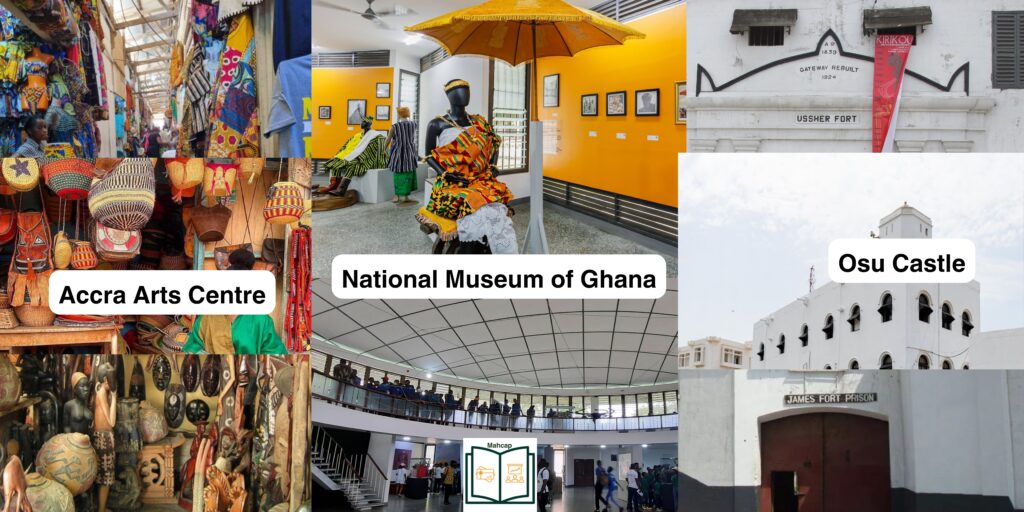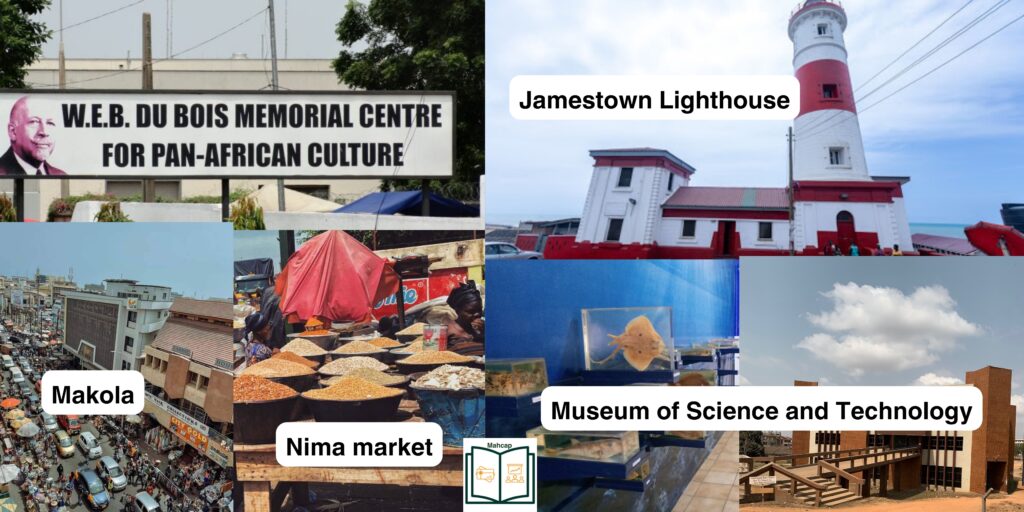Ga People and Top Tourist Attractions in Accra
The Ga-Adangbe people, located in Accra, the vibrant capital city of Ghana, offer tourists varied experiences of a lifetime with its culture, heritage, and natural resources. These include the festivals and culture of the Ga-Adangbe people, beaches, museums, markets, and vibrant nightlife.
Clans of the Ga People of Ghana
The Ga-Adangbe people consist of four clans located in different parts of Accra. After arriving in Ghana after several migrations, the Ga Dangbe clans first settled and are dominant in the following areas.
- Wo Kpele clan: Settled in Tema.
- Wo Krowo clan: Choose Nungua to settle.
- Wo Doku clan: Made La Bone their permanent settlement.
- Wo Sagba clan: Settled in Ga-Mashi-Accra.
Over time, Teshi and Osu were added to the Ga Dangbe states, making the six original Ga states. The Ga people are blessed with vibrant and colourful cultures worth exploring.
Top 10 Tourist Attractions in Accra
The top ten tourist attractions in Accra include.
Homowo Festival
The Ga-Adangbe people celebrate the Homowo festival annually between August and September. It commemorates the period in history when the Ga’s experienced hunger and defeated it with the help of their gods, which blessed them with abundant food. “Homowo” is derived from two Ga words: “homo” (hunger) and “wo (to hoot at). Thus, “Homowo” translates to “hooting at hunger.” During the festival, the Ga people partake in various rituals, including consuming a special dish called “kpokpoe,” served with fish-based palm nut soup. Libations are poured, and symbolic offerings are made to ancestral spirits to express gratitude to their gods for providing them with abundant food. Tourists fortunate to visit during this period get to experience the Homowo festivals and culture of the Ga people.

Kwame Nkrumah Memorial Park and Mausoleum
Kwame Nkrumah Memorial Park is in the heart of Accra and contains two principal edifices: the museum and the mausoleum. The mausoleum is where the mortal remains of Nkrumah and his Wife, Fathia, have been interred. Nkrumah’s body was first buried in Guinea before being brought to Nkroful and later to the mausoleum, its final resting place.
The museum accommodates Nkrumah’s personal belongings. These include books he wrote, photograph archives and official photographs. Also in the museum is the metal coffin donated by the people of Guinea when the remains of Nkrumah were returned from Romania to Guinea and later to Nkroful. In the park is the bronze statue of Nkrumah clad in cloth with his hand symbolically pointing forward. It stands at the same place Nkrumah stood to declare Ghana’s Independence from British colonial rule on March 6, 1957. The park is open to tourists always except on Sundays.
Beaches (Labadi Beach)
Accra boasts many beaches, the busiest of which is Labadi Beach, also called La Pleasure Beach. It is in a town called La, popularly known as Labadi, near Teshie. On holidays and weekends, there are often cultural performances to entertain tourists and guests. Many people go to Labadi Beach to swim, sunbathe, surf, and enjoy the great food offered by the restaurants. It is a place to relax and take a walk to clear your mind.
When the waters become too dark and dangerous to swim in, visitors are entertained throughout the night by live bands, reggae artists, and disco and pop DJs. It welcomes visitors daily.

Accra Art Centre
Accra Arts Centre, also called Centre for National Culture, was established in 1957 by Dr. Kwame Nkrumah to promote traditional Ghanaian arts and culture. It is situated next to the Kwame Nkrumah Memorial Park. The Art Centre is known as Ghana’s tourist heaven for souvenirs and experiences of Ghanaian culture and products. It exhibits and sells locally made traditional handicrafts such as woven kente cloths, sculptures, paintings, carvings, leather bags, batik, jewelry, beads, African costumes, and woven baskets. The products depict Ghana’s history and heritage.
National Museum of Ghana
The National Museum of Ghana is the largest and oldest of the six museums in Accra. It was opened on March 5, 1957, as part of Ghana’s independence celebrations. The museum has a collection of archaeological artifacts, ethnographic objects, and works of art from the pre-colonial, colonial, and post-colonial periods. The Archaeology section houses a collection of Stone Age tools and gold jewelry. The Ethnography section displays traditional Ghanaian clothing, textiles, and musical instruments. The Art section features paintings, sculptures, and woodcarvings.
Museum of Science and Technology
The Museum of Science and Technology is a product of a collaboration between academia and politics. In 1963, two lecturers from the University of Ghana submitted a proposal to Dr. Kwame Nkrumah to create awareness of historical and contemporary advancements in science and technology. Dr. Nkrumah embraced their vision, establishing the Museum for Science and Technology in 1965 as a perpetual source of inspiration. The museum showcased historical items related to communication, transportation, the animal world, and human biology. While these artifacts hold significance in Ghana’s history and highlight the global evolution of technology, they do little to inspire the next generation in the fields of science and technology. In its present state, the museum’s collection seems somewhat limited in terms of showcasing dynamic and modern scientific innovations. However, though the museum may not entirely embody the envisioned narrative of scientific innovation, it remains an essential landmark in Ghana’s history as a product of the collaboration between academia and political leaders. Also, with the right investment, the museum has the potential to evolve into a modern scientific museum that bridges the past with the present and the future.
Jamestown Lighthouse
Jamestown Lighthouse was built in the 1930s to replace the old one dating back to 1871. The British built the original lighthouse in the colonial era to warn ships and guide vessels to navigate safely into and out of harbours.
The Lighthouse is a 28-meter (92 ft) tall structure consisting of a stone tower with a lantern and gallery attached to a keeper’s house. Both the lighthouse and the keeper’s house are painted with red and white horizontal bands. The Lighthouse offers stunning views of the city and the Atlantic Ocean and reminds visitors of Ghana’s colonial past.
Forts and Castles in Accra
James Fort Prison
Often referred to as Fort James, this historical site is adjacent to the Lighthouse. Initially serving as a prison from the colonial era until 2008, it has since been transformed into a museum and holds the prestigious designation of a UNESCO World Heritage Site. Kwame Nkrumah was imprisoned from 1950 to 1951 in Fort James due to his role in demanding independence. Also, Kobina Sekyi, a Ghanaian playwright and lawyer, found himself confined within these walls in 1920 due to his anti-colonial writings. Sekyi was popular for his involvement in the Aborigines Rights Protection Society (ARPS), an organization that triumphed over the British Land Bill of 1897.
Ussher Fort
Originally known as Fort Crèvecœur and constructed in 1649 by the Dutch and subsequently claimed by the British, Ussher Fort is a testament to Ghana’s historical journey. Over its storied existence, the fort has served multifarious purposes, transitioning from a trading post to a prison and eventually a slave castle. Today, Ussher Fort is a museum, a custodian of Ghana’s history, and a revered UNESCO World Heritage Site.
Osu Castle
Christianborg Fort, known as Osu Castle, was built in 1659 by the Danes as an outpost for the commodity trade and later for the transatlantic slave trade. Throughout its history, it has been used as a prison, colonial post, and post-colonial administration. Today, it is a museum and a UNESCO World Heritage Site that narrates and unveils Ghana’s history.
The forts and castles are for learning purposes, to facilitate reconciliation, and to ensure that inhuman acts that occurred within their walls in Ghana never happen again.

W.E.B. DuBois Centre
Dr. DuBois met Nkrumah in 1945 at the fifth Pan-African Congress in Manchester, England, and introduced him to George Padmore. The trio became friends. In 1961, Dr. DuBois accepted Nkrumah’s invitation and became the first director of the Encyclopedia Africana project, making Ghana his home and becoming a Ghanaian citizen.
Dr. DuBois was born in Great Barrington, Massachusetts, on February 23, 1868. He was the first African American to obtain a Havard doctorate. His thesis was “The Suppression of African Slave Trade to the United States of America, 1638-1870.”
Dr. DuBois became a source of inspiration and advice for freedom fighters and leaders of independent African States. The W.E.B. DuBois Centre was established by the government of Ghana in 1985 to honour the memory of Dr. DuBois and promote his Pan-African ideas. The museum, which was the house he lived in, now contains his and his wife’s mortal remains and personal belongings.
Vibrant Markets
Makola Market
Makola Market was constructed in Accra in 1924 and stands at the heart of urban Ghanaian life. It is one of the largest markets in West Africa, and many have described it as where you can get anything you are looking for in the world. Typical Ghanaian markets are dominated by women traders who sell local and imported goods, from textiles to shoes, food, lifestyle, fashion, tools, medicine, jewellery, and pots.
Nima Market
If you are looking for quality products at cheap prices, Nima Market is the best place to go. It is a market mainly for the Muslim and Zongo communities but now serves everyone. They get their goods directly from the villages and the north of Ghana. Wednesdays are market days, and the market is crowded with vendors selling produce, cattle, grains, and cereals, including local cheese and cow milk. Nima Market is a great place to experience Ghanaian culture and grains. With roots dating back to 1836, Nima is regarded as the biggest and one of the oldest Zongo settlements in Ghana.
Therefore, Accra has everything for tourists who love to have fun, experience novelty, acquire new knowledge, explore nostalgia and Ghana’s heritage, and embrace their identity.
By: Huzeima Mahamadu(Researcher and Storyteller)
